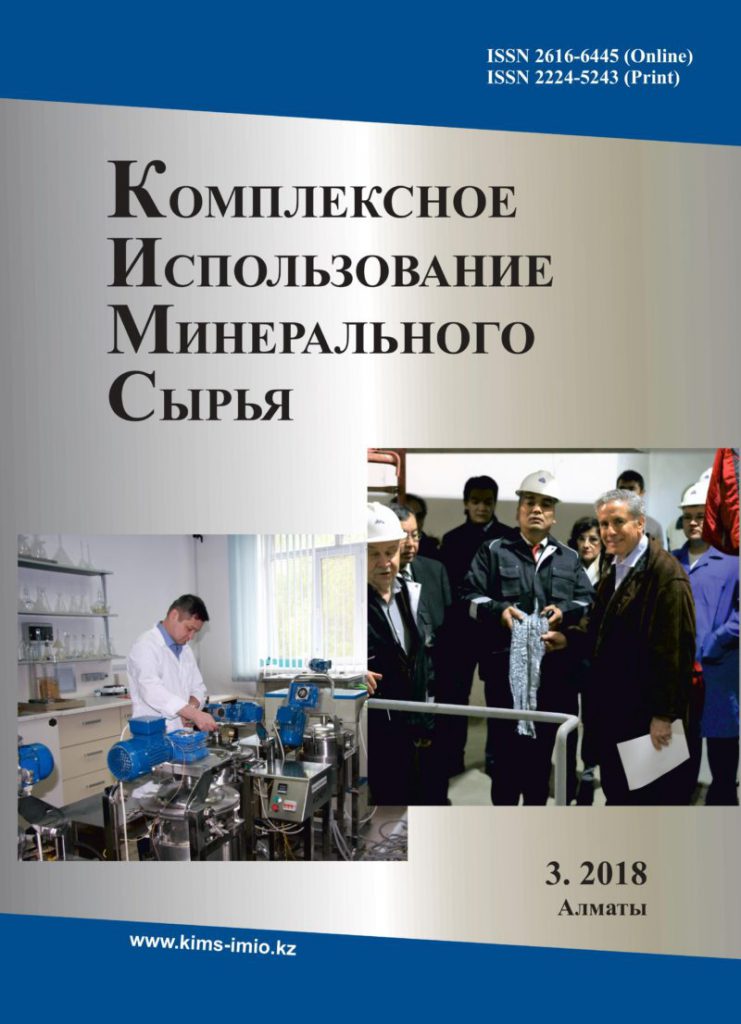Determination of structure and properties of ferriferous sand of aluminous production for search of ways for their processing
DOI:
https://doi.org/10.31643/2018/6445.19Keywords:
ferriferous sands, production wastes, phase composition, pigments, cast iron.Abstract
The need to involve the production wastes – ferrous sands of the Pavlodar aluminum plant into the processing is associated not only with environmental protection, but also with the necessity to increase alumina production, complex waste utilization and the sintering process normalization. For high-iron bauxites effective using in the early stage of the process, the maximum separation of ferriferous sands from bauxite is carried out. The waste flow of ferriferous sands is 50 t/h, which are 10 % from general flow of feed bauxite. It contains up to 60 % of iron oxide and 17 % of aluminum oxide, which is irretrievably lost, reducing the overall extraction of alumina from bauxite. To involve production wastes in the processing, detailed physicochemical studies of the composition of ferriferous sand by methods as follows: X-ray, optical, thermal, phase and chemical analyzes of the fractions from +1 to -0.15 mm were carried out. It is shown that with the decrease of the fraction, the content of iron oxides (56.3-60.9 %) increases, and the content of aluminum oxide decreases (13.4-10.4 %). X-ray analysis of the averaged sample showed that the main iron-containing components in the ferriferous sands are, %: hematite 29.1; hetite 8.6; magnetite 6.19; siderite 8.14; as well as pyrite and andradite – by 2.58. Aluminum-containing phases are, %: gibbsite 11.6; serpentine 8.94 and kaolinite 7. The composition also includes concomitants, %: quartz 5.8; calcite 8.49 and gypsum 3.7. The performed thermal analysis also confirmed the presence of identified phases. The decomposition and oxidation temperatures of the components that occur with increasing temperature were determined. The obtained data on the phase composition and its transformations are necessary when developing methods for the ferriferous sands utilization. An analysis of the physicochemical data of ferriferous sands’ composition has shown that they can be considered as a potential raw material for pigments and cast iron production. The development of new technical solutions aimed at the involvement of production wastes – ferriferous sands in the process will increase the profitability of the existing alumina production by low-quality high-iron bauxite processing.
Downloads
References
Ibragimov A.T., Budon S.V. Razvitiye tekhnologii proizvodstva glinozema i zboksitov Kazakhstana. (Development of alumina production technology from bauxite in Kazakhstan). Pavlodar: Press House, 2010. 304. (in Russ.)
Ivanov A.I., Kozhevnikov G.N., Sitdikov F.G., Ivanova L.P. Kompleksnaya pererabotka boksitov. (Complex processing of bauxite). Ekaterinburg: UrO RAN, 2003. 180. (in Russ.)
Shmorgunenko N.S., Kornev V.I. Kompleksnaya pererabotka i ispol'zovaniye otval'nykh shlamov glinozemnogo proizvodstva. (Complex processing and use of sludge slimes of alumina production). Moscow: metallurgy)1982. 128. (in Russ.)
Ni L.P., Lovashi I., Zazubin A.I., Yevseyev Yu.N. K voprosu o kompleksnoj pererabotke krasnykh shlamov(On the issue of complex processing of red muds). Vestn. AN Kaz SSR= Herald of AS Kaz SSR.1975. 1. 30-33.(in Russ.).
Borra C.R., Pontikes Y., Binnemans K., Gerven T.V. Leaching of rare earthes from bauxite residue (red mud). Minerals Engineering. 2015. 76. 20-27. https://doi.org/10.1016/j.mineng.2015.01.005
Mishra B., Staley A., Kirkpatrick D. Recovery and utilization of iron from red mud. Light Metals. 2001. 1.149-156. (in Eng.)
Mingjun Rao, Jinqiang Zhuang, Guanghui Li, Jinghua Zeng, Tao Jiang. Iron Recovery from Red Mud by Reduction Roasting-Magnetic Separation. Light Metals. 2013. 1. 125-130. (in Eng.)
Sellaeg H., Kolbeinsen L., Safarian J. Iron Separation from Bauxite through Smelting-Reduction Process. Light Metals.2017. 1. 127-135. https://doi.org/10.1007/978-3-319-51541.0_19
Pat. 2047631 RU. Sposob polucheniya zhelezookisnykh pigmentov (Method for obtaining iron-oxide pigments). Kalinichenko I.I., Sokolov V.I., NikonenkoYe.A., Kolesnikova M.P., Purtov A.I. Opubl.10.11.1995. Bul.31. (in Russ.)
Pat. 2346018 RU. Sposob polucheniya chernogo zhelezookisnogo pigmenta(A method for obtaining a black ferric oxide pigment). Ismagilova G.V., Kolesnikova M.P., Kuznetsov A.I., Kuptsov S.G., NikonenkoYe.A.,Rukhlyadeva M.S., Sokolov V.I. Publ. 10.02.2009. Bul.4. (in Russ.)
Pat. 2131444 RU. Sposob proizvodstva zhelezookisnykh pigmentov (Method of production of iron-oxide pigments). Savchenko A.I., Chernobuk Yu.N., Zav'yalova G.G., Turkin Yu.I., Svinin P.A., Nikolayeva Y.A. Publ. 10.06.1999. Bul.16. (in Russ.)
Samchenko S.V., Zemskova O.V., Kozlova I.V. Tekhnologiya pigmentov i krasitelej. (Technology of pigments and dyes). Uchebnoe posobiye dlya VUZov.(Tutorial for Higher school) Moscow: NIU MGSU, 2015. 151. (in Russ.)
Shpigel'khauyer Sh. Neorganicheskiye zhelezookisnyye pigmenty i ikh primeneniye v lakokrasochnykh materialakh. (Inorganic iron oxide pigments and their use in paint and varnish materials). RuColor: sb. dokl. I-oj mezhdunar. konf. (RuColor: proceedings of 1stintrnation. conf.) 10.12 September. 2014. [Electron. resource]. http://www.rucolor.com/upload/iblock/737/04.pdf. (in Russ.)
Vegman Y.F., Zherebin B. N., Pokhvisnev A. N. Metallurgiya chuguna. (Metallurgy of cast iron). Moscow: Akademkniga, 2004. 774. (in Russ.)
Kovzalenko V.A., Sarsenbaj G., Sadykov N. M., Abdulvaliyev R.A. Kompleksnaya pererabotka kaolinitovykh glin s polucheniyem promyshlennykh produktov. (Complex processing of kaolinite clays with obtaining of industrial products). Kompleksnoe ispol'zovanie mineral'nogo syr'ya = Complex use of mineral resources. 2018. 1. 26-33. (in Russ.)
Downloads
Published
How to Cite
Issue
Section
License
Copyright (c) 2022 Pozmogov, V., Kuldeev, E., Dorofeev, D., Imangalieva, L., & Kvyatkovskaya, M.

This work is licensed under a Creative Commons Attribution-NonCommercial-NoDerivatives 3.0 Unported License.


























